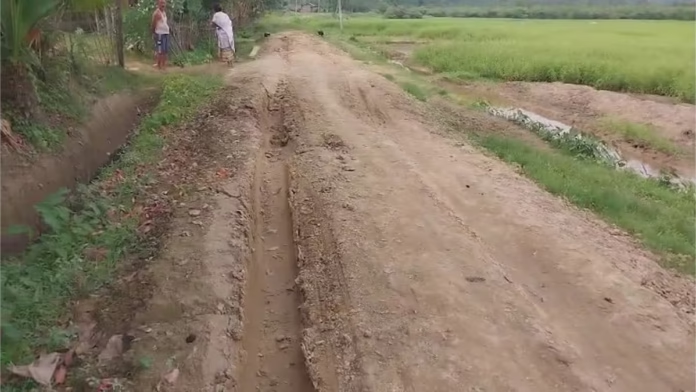In Assam’s Margherita, the Lanka area under No. 1 Bhoitorpawai in the Bhoitorpawai Gaon Panchayat tells a troubling story of neglect and frustration. Home to over 500 voters, this settlement remains cut off from basic transportation infrastructure. Despite promises of rapid development by the BJP-led Assam government, the residents of this region continue to live without a motorable road. During monsoons, the situation turns worse, with residents forced to wade through knee-deep mud or trek long distances on foot to reach essential services.
The locals have voiced their grievances multiple times, but their appeals to authorities have gone unheard. Residents rely on temporary bamboo bridges and narrow, slippery trails to move around. For the elderly and the ailing, reaching the nearest hospital becomes a life-threatening challenge. Schoolchildren struggle daily to attend classes, often slipping and injuring themselves. Farmers, who form the backbone of the community, fail to transport their produce to markets on time, leading to financial losses and a decline in livelihood.
Local leaders have visited the area on various occasions, offering assurances and laying foundation stones with much fanfare. But the promises vanish once elections conclude. The area’s voters, despite consistently participating in the democratic process, feel abandoned and betrayed. The lack of connectivity hampers access to healthcare, education, employment, and even emergency services.
Residents say their frustrations have peaked in recent years. The delay in road construction has been justified under various pretexts—ranging from lack of funds to pending clearances. However, locals believe that the real issue is apathy from the administration. Several NGOs have also highlighted the plight of the villagers in reports sent to district authorities, but the problems persist.
Bhoitorpawai Gaon Panchayat officials have acknowledged the area’s poor infrastructure, stating that proposals for road construction have been submitted. However, deadlines remain unclear and no visible work has begun. The community continues to wait. They see no bulldozers, no concrete mixers, and no signs of surveyors. Just silence.
Local youth have started online campaigns to draw attention to their plight. Through videos and social media posts, they have begun sharing ground realities in hopes of pressuring decision-makers. Their efforts have attracted support from activists and citizens from other regions, but the government’s response has remained lukewarm.
One young woman, a college student from the village, said that she often misses exams due to the lack of transportation. She described how she had to walk for hours through dense foliage just to reach the main road. Elderly residents expressed similar woes, with many unable to access hospitals for regular treatment.
A local teacher spoke about the high dropout rate in the nearby primary school. According to him, many children stop attending classes after the rainy season begins because the muddy paths become too dangerous. He fears the situation will worsen if officials don’t act soon.
The region holds political importance in the Margherita constituency, yet the glaring neglect has made many question the effectiveness of their elected representatives. Political observers believe such cases of local infrastructure failure could play a decisive role in upcoming elections. Voters, once loyal, are beginning to demand accountability and visible results.
Despite all odds, the community remains hopeful. They believe that their persistent voices will eventually break through the political noise. Until then, they continue their daily struggle on foot, battling isolation and disappointment.
The situation in No. 1 Bhoitorpawai stands as a symbol of a deeper problem—where political promises fall flat in the face of administrative inaction. Unless urgent steps are taken to construct an all-weather road, the lives of hundreds will remain on hold. Their journey toward a better future cannot begin unless they first have a road to walk on.
The region’s dire condition has also affected government outreach programs. Health camps, vaccination drives, and agricultural workshops seldom reach the village due to the inaccessibility. Officials hesitate to visit, citing the lack of safe transport routes. As a result, many residents miss out on crucial welfare schemes and remain disconnected from government initiatives that could improve their quality of life.
During election campaigns, candidates have repeatedly made public commitments to prioritize the road construction. However, these commitments vanish with the election results. Residents have grown wary of hollow promises and are now demanding written assurances and timelines. Some have even proposed boycotting future elections if authorities continue to ignore their basic demands.
Community elders recall that the issue of poor road connectivity has persisted for over two decades. Several proposals and surveys took place in the past, but each one disappeared into administrative red tape. The villagers say that their only hope now lies in collective protest and public awareness. They have begun organizing small gatherings and planning larger demonstrations to pressure local and state officials.
Environmental factors also compound the problem. The area experiences heavy rainfall, which further erodes the makeshift paths and delays any temporary fixes. Locals argue that a permanent, concrete road is the only solution. Temporary gravel paths and bamboo bridges have failed repeatedly and wasted both time and resources.
In response to growing public outcry, a few district-level officers have assured an inspection in the coming weeks. But the residents remain skeptical. They want clear action plans, allocated budgets, and actual groundwork to begin—not just visits and verbal promises.
Despite their struggle, the villagers of No. 1 Bhoitorpawai show immense resilience. They continue to hope, to organize, and to raise their voices. Their demand is simple: a road to connect them to the rest of the world, to opportunities, to services, and to a life of dignity. Until that road is built, their fight for visibility and inclusion will not end.

